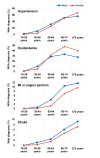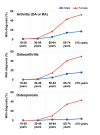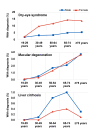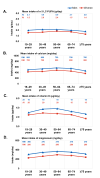A Life-Stage Approach to Precision Nutrition: A Narrative Review
- PMID: 39144414
- PMCID: PMC11322800
- DOI: 10.7759/cureus.66813
A Life-Stage Approach to Precision Nutrition: A Narrative Review
Abstract
The concept of precision nutrition highlights the customization of nutrition to specific needs, emphasizing that a one-size-fits-all approach is not sufficient for either optimal nutrition or optimal health. Precision nutrition encompasses a range of factors, from broad strata of age and sex categories to personal characteristics such as lifestyle to an individual's unique genotype. This breadth of scope requires us to consider how precision nutrition can be implemented in an inclusive and appropriate way for individuals and groups within real-life populations. In this narrative review, we explore the potential of precision nutrition through a life-stage approach that emphasizes age- and gender-specific nutritional needs as these change across the lifespan. Focusing on adult life stages, we delineated trends in age-related conditions and health needs among Korean adults based on national-level survey data (KNHANES 2019-2021). We also reviewed the intake of nutrients associated with these health needs to better understand how life-stage guided approaches to nutrition and supplementation could support optimal health. Looking beyond preventing deficiency or disease, we discuss how tailored supplementation of essential vitamins, minerals, and certain bioactive substances could promote healthy functioning. Finally, we discuss the complexities and challenges of developing multivitamin/multimineral supplements (MVMS) to support life-stage appropriate nutrition while maximizing adherence. Future prospects include leveraging advancements in intelligent technologies and dietary assessments for tracking nutrient intake and health indicators and using these to optimize MVMS formulations in ways that are sensitive to a person's needs and priorities/preferences at different life stages. By adopting a life-stage guided approach to nutrition, we can better support health and well-being across the lifespan.
Keywords: age grouping; health promotion; healthy aging; life stage nutrition; multivitamin and mineral supplements; nutrition; optimal health; precision nutrition.
Copyright © 2024, Yoon et al.
Conflict of interest statement
Conflicts of interest: In compliance with the ICMJE uniform disclosure form, all authors declare the following: Payment/services info: Manuscript drafting and editorial support to the authors was funded by Haleon (formerly GSK Consumer Healthcare Pte Ltd.), and provided by Tech Observer Asia Pacific. Financial relationships: Hye In Lee declare(s) employment from Haleon (formerly GSK Consumer Healthcare Pte Ltd.). Sang Woo Oh declare(s) Served on an advisory board for Haleon from Haleon (formerly GSK Consumer Healthcare Pte Ltd.). Other relationships: All authors have declared that there are no other relationships or activities that could appear to have influenced the submitted work.
Figures





Similar articles
-
The Use of Multivitamin/Multimineral Supplements: A Modified Delphi Consensus Panel Report.Clin Ther. 2018 Apr;40(4):640-657. doi: 10.1016/j.clinthera.2018.02.014. Epub 2018 Mar 21. Clin Ther. 2018. PMID: 29573851 Review.
-
Applications of Metabolomics to Precision Nutrition.Lifestyle Genom. 2022;15(1):1-9. doi: 10.1159/000518489. Epub 2021 Sep 8. Lifestyle Genom. 2022. PMID: 34518463 Review.
-
Effect of a Single Multi-Vitamin and Mineral Supplement on Nutritional Intake in Korean Elderly: Korean National Health and Nutrition Examination Survey 2018-2020.Nutrients. 2023 Mar 23;15(7):1561. doi: 10.3390/nu15071561. Nutrients. 2023. PMID: 37049402 Free PMC article.
-
NIH State-of-the-Science Conference Statement on Multivitamin/Mineral Supplements and Chronic Disease Prevention.NIH Consens State Sci Statements. 2006 May 15-17;23(2):1-30. NIH Consens State Sci Statements. 2006. PMID: 17332802
-
The Evolving Role of Multivitamin/Multimineral Supplement Use among Adults in the Age of Personalized Nutrition.Nutrients. 2018 Feb 22;10(2):248. doi: 10.3390/nu10020248. Nutrients. 2018. PMID: 29470410 Free PMC article. Review.
References
-
- Developmental origins of health and disease: current knowledge and potential mechanisms. Hoffman DJ, Reynolds RM, Hardy DB. Nutr Rev. 2017;75:951–970. - PubMed
-
- Guide and position of the International Society of Nutrigenetics/Nutrigenomics on Personalised Nutrition: Part 1 - fields of precision nutrition. Ferguson LR, De Caterina R, Görman U, et al. J Nutrigenet Nutrigenomics. 2016;9:12–27. - PubMed
-
- Precision nutrition: a review of current approaches and future endeavors. Livingstone KM, Ramos-Lopez O, Pérusse L, Kato H, Ordovas JM, Martínez JA. Trends Food Sci Technol. 2022;128:253–264.
Publication types
LinkOut - more resources
Full Text Sources
